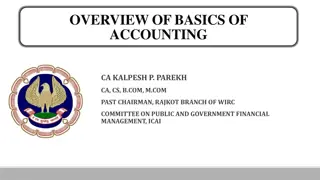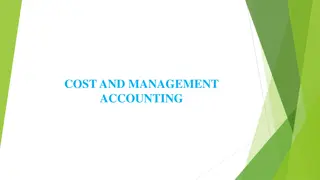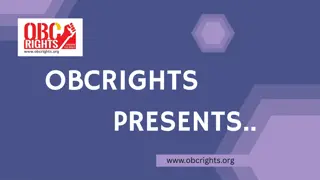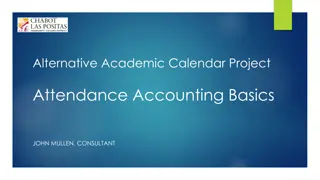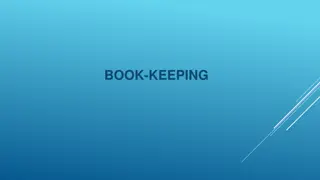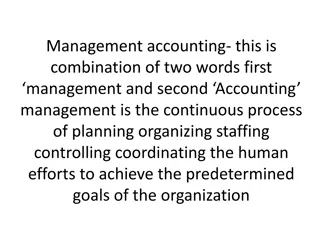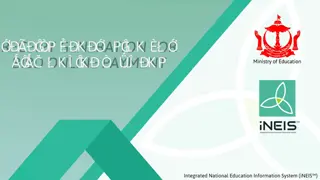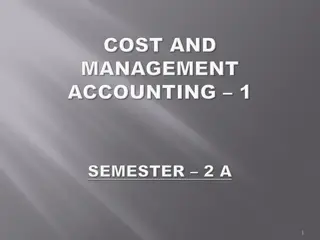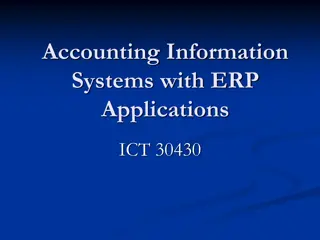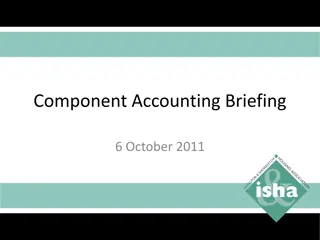Modernizing Government Receipt Accounting in Puducherry
The Government of Puducherry uses a manual Treasury Receipt Accounting System for collecting government remittances, which poses challenges such as misclassification, manual data entry, and difficulty in tracking payments. The proposed system aims to centralize data collection through a web-based platform, streamlining the process and improving efficiency.
Download Presentation

Please find below an Image/Link to download the presentation.
The content on the website is provided AS IS for your information and personal use only. It may not be sold, licensed, or shared on other websites without obtaining consent from the author.If you encounter any issues during the download, it is possible that the publisher has removed the file from their server.
You are allowed to download the files provided on this website for personal or commercial use, subject to the condition that they are used lawfully. All files are the property of their respective owners.
The content on the website is provided AS IS for your information and personal use only. It may not be sold, licensed, or shared on other websites without obtaining consent from the author.
E N D
Presentation Transcript
Government of Puducherry Treasury Receipt Accounting System
Treasury Receipt Accounting System Overview of Treasuries The UT of Puducherry comprises of three Treasuries and three sub-treasuries. The main functions of the Treasuries and Sub-Treasuries are payment of pensions, compilation of Government Payment and Receipt Accounts, issue of Government Stamps and Stamp Papers. In order to collect the government receipts, each and every treasury/sub-treasury has been linked with a bank functioning at its location. The treasuries and sub- treasuries along with the bank linked are tabulated below. Sl.No. Treasury / Sub-treasury Bank authorized The Treasury Office, Puducherry. 1 SBI (Main), Puducherry The Treasury Office, Villianur. 2 UCO Bank, VIllianur The Sub-Treasury Office, Bahour. 3 The Treasury Office, Karaikal. 4 SBI, Karaikal The Sub-Treasury Office, Mahe 5 SBI, Mahe The Sub-Treasury Office, Yanam. 6 SBI, Yanam Directorate of Accounts and Treasuries, Puducherry
Treasury Receipt Accounting System Prevailing Receipt Accounting Government or private, who desires to make any kind of payment to the State Government, shall remit the same into the Treasuries / sub-treasuries Challans. On behalf of each and every treasury/sub-treasury, a bank situated at its jurisdiction has been authorized to collect the remittance and the remittances can be made through Cash/Cheque/DD. At present the agency banks collecting government receipts are sending the remittance details in daily scrolls along with physical challans to the treasury concerned. On receiving the physical challans along with the bank scrolls, treasury officials classifies the remittances based on the head of account under which the remittance has been made. In order to classify the remittances, challan details are fed into computer systems in distributed manner day-by-day and reconciled with the bank scrolls. Directorate of Accounts and Treasuries, Puducherry
Treasury Receipt Accounting System Disadvantages of existing system of receipt accounting Presently government remittances are being made through manual challan. Due to the manual preparation of challans, there is lot of difficulties. Some of them are listed below. Sufficient knowledge on account heads is essential Manual classification of head of accounts involves misclassification Unable to provide up-to-date State Revenue details as and when required Requires more man power Processed under distributed environment State revenue data has to be prepared manually by collecting and compiling all treasury receipts On completion of reconciliation with the bank scrolls, the subscriptions / refunds in respect of GPF / NPS / HBA / MCA/ PCA, etc. are needs to be credited into the account of staff concerned manually Tracking of personal payment is very difficult Treasuries shall keep the physical challans for future reference Challan details are not recorded digitally for future reference Process of refund requires the verification of physical challan, due to non-availability of digital challan. Directorate of Accounts and Treasuries, Puducherry
Treasury Receipt Accounting System Proposed system In order to have centralized data of government remittances, it is proposed to have a web based application. The new application has to enable the departments and DDOs for generating digital challan. Online challan form facilitates minimum fields of the challan to be filled and requires minimum knowledge of Account Heads. Each part of the challan will be stored digitally at transaction level. In case if an official remits GPF contribution through online challan, his remittance particulars including his GPF Account Number, Amount of Contribution, etc. will be stored for future reference and his contribution will be credited into his GPF Account after reconciliation with bank scrolls. Since the challans are prepared online, challan data will be stored centrally for all regions. This will enable us for providing various MIS reports, such as Revenue Report, Remittance Tracking, etc. The new system will be flexible to have P2G (Public to Government) remittances through online in the future. Directorate of Accounts and Treasuries, Puducherry
Treasury Receipt Accounting System Work Flow Diagram Online Challan Tax/Non-tax Web/Data Server Banker1 Treasury 1 Reconciliation Treasury 2 Banker2 Treasury 3 Banker3 Treasury 4 Banker4 Treasury 5 Banker5 Treasury 6 Banker6 Online Challan Register DDO n DDO 1 DDO 2 DDO 3 Directorate of Accounts and Treasuries, Puducherry
Treasury Receipt Accounting System Advantages of the proposed system In the proposed system, challans will be originated by the departments and DDOs through the Online Challan Form. Advantages of the new system are listed below. Challan forms are digital Head of account misclassification and related Transfer Entries can be prevented Compilation process will be simplified Simplified Reconciliation process Facilitated with Online Challan Register Centralized data and secured Consolidated GovernmentRevenue in respect of all regions can be obtained online at any time Knowledge of Account Heads is not must Government employees related remittances in respect of GPF, NPS, MCA, HBA, PCA, etc. will be credited into individual account directly Requires less man power Directorate of Accounts and Treasuries, Puducherry
Treasury Receipt Accounting System Challan Register for Departments / DDOs Departments and DDOs will be facilitated with OnlineChallan Register . The register will contain the abstract of all the remittance particulars pertains to the remitter. In addition to that the online challan register will be updated with the Treasury Receipt Number after taking into government accounts for the purpose of reconciliation and future reference. Role of Departments / DDOs Departments and DDOs have to fill the online challan form for remitting government receipts and physical challan has to be generated from the web application. Online Challans are classified as Tax and Non- Tax. While filling online challan form, the Departments and DDOs can add 10 transactions with each challan. They will get their remittance details in the form of ChallanRegister . The challan register will be updated automatically with Treasury Receipt Number after reconciliation with bank scrolls. Directorate of Accounts and Treasuries, Puducherry
Treasury Receipt Accounting System Role of Treasuries Treasuries will keep track of the online challans to be filled by the departments and DDOs. On receiving bank scrolls along with challans, treasuries will reconcile the remittances and allot a unique Treasury Receipt Number for each challan as a receipt confirmation. Even though the online challan data are available digitally, the physical challan copies also will be kept safely in treasuries concerned for a particular period for future reference. Flexibility The proposed system will be developed in house and flexible to meet out the future requirements. We can easily adopt time-to-time decisions of Government of India relating to Treasury Accounts and Government remittances. Directorate of Accounts and Treasuries, Puducherry
Treasury Receipt Accounting System Conclusion The initiative of Treasury Receipt Accounting System will be the first step in the direction of the implementation of Treasury Mission Mode Project. The new system will be flexible to incorporate the future guidelines of Government of India relating to the treasury remittances. We have designed the new system based on our experience in Treasury Receipt Accounting and hope that this will automate receipt accounting. Further, this will help departments and DDOs in reconciliation with the digital form of challans. Directorate of Accounts and Treasuries, Puducherry





